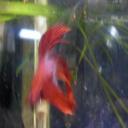Yahoo Answers is shutting down on 4 May 2021 (Eastern Time) and the Yahoo Answers website is now in read-only mode. There will be no changes to other Yahoo properties or services, or your Yahoo account. You can find more information about the Yahoo Answers shutdown and how to download your data on this help page.
Angel fish have layed eggs.?
A big surprise, my Angel Fish are breeding, I was wondering why one of them had a go at me this morning when I was syphoning the gravel. Makes sense now.
The pair are fiercely guarding their eggs. Any advice welcome.
I breed livebearers, but this is new to me?
This morning the eggs have been moved and I can see them wriggling. Is this good?
2 Answers
- ?Lv 71 decade agoFavourite answer
If it's the first time they breed, they may end up eating the eggs. This often happens the first 3 or 4 times. If they're alone in the tank, you can leave the fry with the parents for some days after the fry become free swimming. If there are other fish in the tank, you need to remove the fry as soon as possible.
Once the fry become free swimming, you should feed them with micro worms at first and freshly hatched brine shrimp after 5-7 days. If you haven't got those, commercial products are available which can be used for feeding fry from egg-laying species, but in my experience fewer fry will survive on that diet than on a diet of live foods.
Source(s): 30 years in this great hobby. - 5 years ago
If the parents are to be left with the eggs, it is best to provide as much peace and quiet for them as possible. You may want to set up their tank in your bedroom or a spare room where they will not be unnecessarily disturbed. Other than that, they should be treated as you normally do. Some aquarists cover the tank with paper or black plastic and use peep holes to observe the fish. This can cause more disturbance than without the cover because there is no warning for the fish when the lid is going to be opened for feeding or for any other reason. The best system for filtering a fry tank is a seeded corner sponge filter. Start your new Rotifer (roe' tu fur) bacteria colony by putting the new sponge filter with aeration into an established tank. This should be done long before you have to use it so that all you have to do is pop it into the fry tank when the time comes. The sponge will begin to discolor when you have the start of your colony. The circulation of water is gentle, the fry won't be sucked into the sponge and even baby brine shrimp are safe with a sponge filter. Clean the sponge in a bucket of siphoned off aquarium water to protect the Rotifers from dying, wring it out a couple of times and it's ready to go back to work even in a completely bare aquarium. Undergravel filters also work biologically, but are not as convenient to use in this instance. A scrupulously clean aquarium is essential for proper growth and health of your Angel fish fry, but with an undergravel filter, this is almost impossible to do. The water can look crystal clear while the space under the filter can be filthy with uneaten food and fish waste. This in turn causes ammonia build-up which is dangerous or even fatal to fish. It is obviously very difficult if not impossible to keep a fry tank with an undergravel filter in it perfectly clean. Should you decide to remove the eggs after spawning to raise away from the parents, a bare 15-20 gallon tank with sponge filter and a piece of slate leaned up against a side wall would be the angelfish will use the piece of slate to lay their eggs on making it easy for you to remove the entire spawn. A restaurant sized pickle or mayonnaise jar submerged into the tank and the slate with the spawn gently transferred into it is the best way to handle the delicate eggs which should be facing upward. An airstone should be placed in the jar in such a way that the somewhat vigorous stream of air bubbles does not hit the eggs directly. The jar should be floated in the tank so the temperature remains constant and that water changes can come from the parent's tank. Successful breeders have used this 'formula' for the water in which to raise the fry: Dechlorinated tap water measuring about 75-100 ppm hardness or about 5 DH and a pH of about 7.4 and kept at 80-02 degrees F. A one gallon pickle jar was used and tilted, filled 3/4 full and 3 drops of 10% Methylene Blue was added. The aeration was vigorous and each day after hatching, one-half the water was replaced with aged tap water of the same temperature. Aeration was slowed after the fry were free swimming. Hatching should occur in about 36 to 48 hours depending on the temperature. If you should see some eggs fall off the slate, you may elect to either pick them up with an eyedropper or turkey baster and squirt them back on the slate or leave them to hatch where they are. There will be a period after hatching and before free swimming when the fry will stick together. At this time increase the aeration so ALL the fry will have access to sufficient oxygen. Do not put food in the jar until they fry are free swimming. This will only serve to foul the water and they won't eat while they still have a yolk sack to live on. After about 3-5 days when they are free swimming, you may introduce newly hatched brine shrimp into the jar for the fry to eat.



